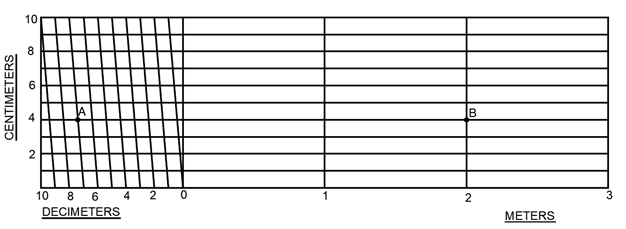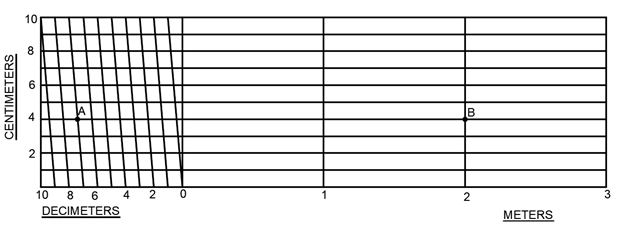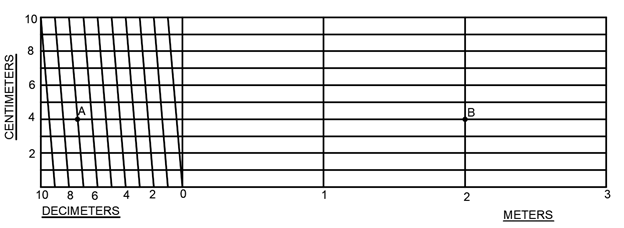This set of Tough Engineering Drawing Questions and Answers focuses on “Diagonal Scales – 2”.
1. Which of the following scales is used when there are three units that need to be measured?
a) Plain scale
b) Comparative scale
c) Diagonal scale
d) Vernier scale
View Answer
Explanation: Diagonal scale is used when three different units of measurements are needed to be measured. With the help of this scale, we can get the reading in three different units. This scale also helps in accurate measurement of minute divisions.
2. Which of the following scales is used to accurately measure minute divisions?
a) Plain scale
b) Diagonal scale
c) Scale of chords
d) Comparative scale
View Answer
Explanation: Minute divisions are accurately measured by using diagonal scales. Diagonal scales are also when three different units of measurements are needed to be measured. With the help of these scales, we can get a relation between three different units.
3. What is the length of AB in the following scale?

a) 2.74 m
b) 3.74 m
c) 2.47 m
d) 3.47 m
View Answer
Explanation: Reading of the diagonal involves reading in three ways. The first measurement is taken in the meters scale, the second is from the decimeters scale and the third is from the centimeters scale. Hence in meters scale, the value is 2 m from 0; in decimeters scale, the value is 7 dm and in the centimeters scale, the value is 4 cm. Hence length of AB = 2.74 m.
4. What is the maximum length of the given scale?

a) 3 dm
b) 4 dm
c) 3 m
d) 4 m
View Answer
Explanation: The maximum length that can be measured using the given scale is 4 meters. It is clear that wee can measure 3 m from the meters scale. The rest 1 meter is measured as 10 decimeter. Hence 3 + 1 = 4 meters is the maximum length.
5. If the given scale is 1: 60, what is the length of the scale?

a) 6.67dm
b) 0.67 cm
c) 6.67 cm
d) 66.67 cm
View Answer
Explanation: The length of the scale is determined by the formula, length of the scale = representative fraction x maximum length to be measured, that is, length of the scale = 1 ÷ 60 x 4 x 100 = 6.67 cm. Hence the length of the scale is 6.67 cm.
6. From the given scale, we can measure 4.56 m.

a) True
b) False
View Answer
Explanation: The maximum length that can be measured is 4 meters. Hence any value beyond 4.00 meters cannot be measured using the above scale. Measuring a value in diagonal scale, the line needs to coincide with one of the line in the scale and not go beyond it.
7. From the given scale below, what is the length of PQ?

a) 3 yd 2 ft 0”
b) 3 yd 1 ft 10”
c) 3 yd 0 ft 10”
d) 4 yd 2 ft 0”
View Answer
Explanation: The distance from the 0 on the horizontal to the point Q is 3 yards. In the feet scale, the point P lies on 1 feet and in the inches scale, the point P lies on 10 inches. Hence, the length of PQ is 3 yards 1 foot 10 inches.
8. What is the maximum length that can be measured using the given scale?

a) 6 yards
b) 5 yards
c) 6 feet
d) 15 feet
View Answer
Explanation: It is clear that we can measure up to 5 yards directly. But in addition to the five yards, we have 3 feet in the feet scale which equals to one yard. Hence the maximum length that can be measured is 6 yards.
9. What is the length of the scale, if the scale is 1:30?

a) 0.6 yard
b) 7.2 feet
c) 0.2 feet
d) 7.2 inches
View Answer
Explanation: The length of the scale is measured as; length of the scale = representative fraction x maximum length to be measured. Hence, length of the scale = 1 ÷ 30 x 6 x 3 x 12 = 7.2 inches. Representative fraction for the scale 1:30 is 1/30.
10. From the given scale, we can measure 5 yards 3 feet and 0 inches.

a) True
b) False
View Answer
Explanation: We can measure 5 yards and 3 feet using the given scale, as 5 yards are clearly indicated on the yards scale and 3 feet is also indicated on the feet scale. 3 feet equals 1 yard. Hence, 5 yard 3 feet is nothing but 6 yards and that is the maximum length that can be measured by the scale.
Sanfoundry Global Education & Learning Series – Engineering Drawing.
To practice Tough questions and answers on all areas of Engineering Drawing, here is complete set of 1000+ Multiple Choice Questions and Answers.
If you find a mistake in question / option / answer, kindly take a screenshot and email to [email protected]
